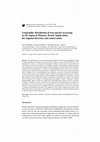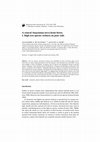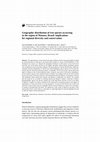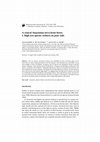Papers by Alexandre A de Oliveira

The alpha-diversity of trees found in the region of Manaus, Brazil is among the highest recorded ... more The alpha-diversity of trees found in the region of Manaus, Brazil is among the highest recorded for one-hectare plots in Amazonia or any tropical forest. Based on a survey of the distributions of 2541 Neotropical tree species, we analyzed the geographic distribution of 364 species of terra firme forest trees that occur in the region and that are not edaphic specialists. Fifteen distinct distribution patterns were recognized for trees occurring in Manaus. The great majority of species (84.9%) have continuous, somewhat restricted distributions, 35 (9.6%) show broad distributions and 20 species (5.5%) show disjunction between Amazonia and Eastern Brazil. A remarkable 150 (41.2%) of these species showed the region of Manaus as one of their distribution limits. Using the same pool of 2541 species distributions, the percentage of species with a distribution limit in Manaus was compared with that for other localities known to be centers of botanical collection. The null hypothesis that the difference in proportion of species with distribution limits among these localities and Manaus is insignificant was rejected. We conclude that the results are not an artifact of collecting density, that Manaus is indeed a crossroads of distinct phytogeographic regions, and that this explains part of the high species diversity of trees in the region of Manaus. A number of scenarios proposed for the Pleistocene in Amazonia postulate some degree of fragmentation of Amazonian forests or at least populations. As much as these theories may conflict with each other in some respects, they are compatible with the concept of Manaus as a region of re-convergence of isolated or disrupted floras and faunas. The significance of the vicinity of Manaus in the history of the Amazon flora and its current status as a repository for surprisingly high tree diversity highlights the need to make this region a conservation priority.

Tree size, density, and species richness were established for three one-hectare plots of terra fi... more Tree size, density, and species richness were established for three one-hectare plots of terra firme forest in central Amazonian Brazil. In the three hectares, 1916 individual trees with DBH ≥10 cm were sampled. A total of 58 families, 181 genera, and 513 species were determined. Hectare A had 285 species, 138 genera, and 47 families; hectare B 280 species, 123 genera, and 48 families; and hectare C 280 species, 125 genera, and 44 families. Comparably high species richness in Amazonia has heretofore only been reported from western Amazonia. This dispels the idea that high species richness can only develop in areas with rich soils and relatively high rainfall. It is suggested that such high species richness is the result of a combination of habitat heterogeneity and geological history. These high diversity forests, because they occur on nutrient poor soils, can be protected with little or no impact on development in the region because the soils are essentially useless for agriculture and for supporting long-term cattle pasture.
Litter decomposition recycles nutrients and causes large fluxes of carbon dioxide into the atmosp... more Litter decomposition recycles nutrients and causes large fluxes of carbon dioxide into the atmosphere. It is typically assumed that climate, litter quality and decomposer communities determine litter decay rates, yet few comparative studies have examined their relative contributions in tropical forests. 2. We used a short-term litterbag experiment to quantify the effects of litter quality, placement and mesofaunal exclusion on decomposition in 23 tropical forests in 14 countries. Annual precipitation varied among sites (760-5797 mm). At each site, two standard substrates ( Raphia farinifera and Laurus nobilis ) were decomposed in fine-and coarse-mesh litterbags both above and below ground for approximately 1 year.

by Perry Ong, Tomáš Vrška, Alberto Vicentini, Jonathan Myers, Keping Ma, Renato Valencia, Xiangcheng Mi, Lisa Korte, Sarayudh Bunyavejchewin, James Lutz, Shawn Lum, Keith Clay, Fangliang He, Jennifer Baltzer, S. Hubbell, and Alexandre A de Oliveira Global Change Biology, 2014
Global change is impacting forests worldwide, threatening biodiversity and ecosystem services inc... more Global change is impacting forests worldwide, threatening biodiversity and ecosystem services including climate regulation. Understanding how forests respond is critical to forest conservation and climate protection. This review describes an international network of 59 long-term forest dynamics research sites (CTFS-ForestGEO) useful for characterizing forest responses to global change. Within very large plots (median size 25 ha), all stems ≥1 cm diameter are identified to species, mapped, and regularly recensused according to standardized protocols. CTFS-ForestGEO spans 25°S-61°N latitude, is generally representative of the range of bioclimatic, edaphic, and topographic conditions experienced by forests worldwide, and is the only forest monitoring network that applies a standardized protocol to each of the…

The alpha-diversity of trees found in the region of Manaus, Brazil is among the highest recorded ... more The alpha-diversity of trees found in the region of Manaus, Brazil is among the highest recorded for one-hectare plots in Amazonia or any tropical forest. Based on a survey of the distributions of 2541 Neotropical tree species, we analyzed the geographic distribution of 364 species of terra firme forest trees that occur in the region and that are not edaphic specialists. Fifteen distinct distribution patterns were recognized for trees occurring in Manaus. The great majority of species (84.9%) have continuous, somewhat restricted distributions, 35 (9.6%) show broad distributions and 20 species (5.5%) show disjunction between Amazonia and Eastern Brazil. A remarkable 150 (41.2%) of these species showed the region of Manaus as one of their distribution limits. Using the same pool of 2541 species distributions, the percentage of species with a distribution limit in Manaus was compared with that for other localities known to be centers of botanical collection. The null hypothesis that the difference in proportion of species with distribution limits among these localities and Manaus is insignificant was rejected. We conclude that the results are not an artifact of collecting density, that Manaus is indeed a crossroads of distinct phytogeographic regions, and that this explains part of the high species diversity of trees in the region of Manaus. A number of scenarios proposed for the Pleistocene in Amazonia postulate some degree of fragmentation of Amazonian forests or at least populations. As much as these theories may conflict with each other in some respects, they are compatible with the concept of Manaus as a region of re-convergence of isolated or disrupted floras and faunas. The significance of the vicinity of Manaus in the history of the Amazon flora and its current status as a repository for surprisingly high tree diversity highlights the need to make this region a conservation priority.

Tree size, density, and species richness were established for three one-hectare plots of terra fi... more Tree size, density, and species richness were established for three one-hectare plots of terra firme forest in central Amazonian Brazil. In the three hectares, 1916 individual trees with DBH ≥10 cm were sampled. A total of 58 families, 181 genera, and 513 species were determined. Hectare A had 285 species, 138 genera, and 47 families; hectare B 280 species, 123 genera, and 48 families; and hectare C 280 species, 125 genera, and 44 families. Comparably high species richness in Amazonia has heretofore only been reported from western Amazonia. This dispels the idea that high species richness can only develop in areas with rich soils and relatively high rainfall. It is suggested that such high species richness is the result of a combination of habitat heterogeneity and geological history. These high diversity forests, because they occur on nutrient poor soils, can be protected with little or no impact on development in the region because the soils are essentially useless for agriculture and for supporting long-term cattle pasture.
Litter decomposition recycles nutrients and causes large fluxes of carbon dioxide into the atmosp... more Litter decomposition recycles nutrients and causes large fluxes of carbon dioxide into the atmosphere. It is typically assumed that climate, litter quality and decomposer communities determine litter decay rates, yet few comparative studies have examined their relative contributions in tropical forests. 2. We used a short-term litterbag experiment to quantify the effects of litter quality, placement and mesofaunal exclusion on decomposition in 23 tropical forests in 14 countries. Annual precipitation varied among sites (760-5797 mm). At each site, two standard substrates ( Raphia farinifera and Laurus nobilis ) were decomposed in fine-and coarse-mesh litterbags both above and below ground for approximately 1 year.
by Claudia Baider, Edward Jimmy Alarcon Mozombite, Alexandre A de Oliveira, Milton Tirado, Cid Ferreira, Doug Daly, Italo Mesones, Roderick Zagt, Ademir Roberto Ruschel, Francisco Dallmeier, David A Neill, Tinde van Andel, Hernan Castellanos, Rodolfo Vasquez, César I A Vela, Flávia Costa, susan laurance, Uneg Hernandez, Stanford & Eglee Zent, Hirma Ramírez, Ligia Urrego, Jean-François Molino, Maria Mora, Marcos Ríos, and Lionel Hernandez Science, 2013


Uploads
Papers by Alexandre A de Oliveira